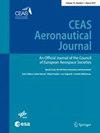基于RANS仿真的跨声速飞机飞行包线气动极限估计准则综述
Q2 Engineering
引用次数: 0
摘要
飞机飞行包线的气动极限对飞机的飞行特性和载荷起着重要的作用,因此在飞机设计初期就必须对其进行估算。然而,如果没有风洞试验或昂贵的尺度模拟,很难做出准确的预测。从计算的角度来看,这个问题可以分为两个部分:(1)生成包络线条件下的有效流动解,(2)从这些计算中提取精确的升力极限。不仅第一点非常具有挑战性,第二点也是如此。在低马赫数时,升力极限可以相对容易地检测到,但在中等马赫数时,最大升力和升力极限不再必然重合,因为在达到最大升力之前,实际可达到的升力可能受到跨音速冲击的限制。由于只有使用时间分辨CFD方法才能准确预测冲击本身,因此需要使用间接标准来估计基于稳定RANS模拟的升力极限。这是本文的重点。为此,提出了文献中提出的各种标准,并将其应用于测试用例并进行了比较评估。针对试验用例,进行了不同马赫数和攻角下通用翼机身构型LEISA的稳态RANS仿真。最后,对不同标准的优缺点进行了识别和讨论。本文章由计算机程序翻译,如有差异,请以英文原文为准。
Overview of criteria to estimate aerodynamic limits of the flight envelope of a transonic aircraft based on RANS simulations
Abstract The aerodynamic limits of the flight envelope of an aircraft play an important role for flight characteristics and loads, so they must be estimated already in the early stages of aircraft design. However, without wind tunnel tests or costly scale-resolving simulations, it is difficult to make an accurate prediction. From a computational perspective, this problem can be split into two parts: (1) generating a valid flow solution for edge-of-the-envelope conditions and (2) extracting the exact lift limit from these computations. Not only the first point can be very challenging, but also the second point. At low Mach numbers, the lift limit may be detected relatively easily, but already at moderate Mach numbers, maximum lift and the lift limit do not necessarily coincide any more, as the actual achievable lift may be limited by the onset of transonic buffet before maximum lift is achieved. Since buffet itself can only be predicted accurately with high effort using time-resolving CFD methods, indirect criteria are required for estimating the lift limit based on steady RANS simulations. This is the focus of the present paper. For this purpose, various criteria proposed in the literature are presented, applied to a test case and comparatively evaluated. For the test case, steady RANS simulations of the generic wing-fuselage configuration LEISA at different Mach numbers and angles of attack are carried out. Finally, the advantages and disadvantages of the different criteria are identified and discussed.
求助全文
通过发布文献求助,成功后即可免费获取论文全文。
去求助
来源期刊

CEAS Aeronautical Journal
Engineering-Aerospace Engineering
CiteScore
3.40
自引率
0.00%
发文量
53
期刊介绍:
The CEAS Aeronautical Journal has been created under the umbrella of CEAS to provide an appropriate platform for excellent scientific publications submitted by scientists and engineers. The German Aerospace Center (DLR) and the European Space Agency (ESA) support the Journal.The Journal is devoted to publishing results and findings in all areas of aeronautics-related science and technology as well as reports on new developments in design and manufacturing of aircraft, rotorcraft, and unmanned aerial vehicles. Of interest are also (invited) in-depth reviews of the status of development in specific areas of relevance to aeronautics, and descriptions of the potential way forward. Typical disciplines of interest include flight physics and aerodynamics, aeroelasticity and structural mechanics, aeroacoustics, structures and materials, flight mechanics and flight control, systems, flight guidance, air traffic management, communication, navigation and surveillance, aircraft and aircraft design, rotorcraft and propulsion.The Journal publishes peer-reviewed original articles, (invited) reviews and short communications.
 求助内容:
求助内容: 应助结果提醒方式:
应助结果提醒方式:


